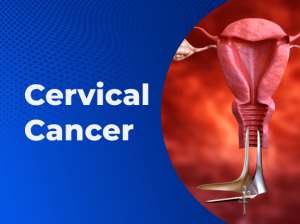
January is Cervical Health Awareness Month. Today, I will discuss Cervical Cancer prevention, screening and vaccination.
Each year, about 270,000 women die from it worldwide, with 90% occurring in low/middle-income countries, where Cervical Cancer incidence is twice as high, and the death rates are three times higher as in high income countries. The latter, have over several decades been screening women for cervical cancer with the use of PAP smears and more recently with the addition of testing for Human Papilloma Virus (HPV), the virus which causes most cervical cancers.
These countries also have high vaccination rates against HPV, and early treatment of Pre-Cancer and Cancer Lesions. Low resource nations have lagged behind due to low national priorities, lack of willingness, finances, and other reasons. In November 2020, the WHO launched the “Global Strategy to accelerate the elimination of Cervical Cancer” with target of 90% of girls fully vaccinated by the age of 15 years, 70% of women screened by the age of 35 to 45 years, 90% treatment of precancerous lesions and management of 90% of invasive cancer cases”. The strategy uses a 3 prone approach of 1. Prevention through Vaccination and Education 2. Effective screening for pre cancer lesions 3. Treatment of pre-cancerous lesions, early cancer diagnosis and programs for the management of invasive cancer.
How Cervical Cancer develops
The cervix is the lower part (or neck) of the uterus or womb. Most cervical cancers are the result of persistence of types of HPV known as “high risk” HPV. Over time they cause cells on the cervix to become abnormal. It may take about 10 years for HPV infected cells to change to cancer cells. However, if these cells are discovered early, they can be treated by destroying the cells on the surface of the cervix. If not detected early by Cervical Precancer screening tests, the abnormal cells may become cancerous. Other cancers resulting from HPV infection affect the following areas: Vulva, Vagina, Back of throat, Penis, and Anal/Rectum.
Prevention of Cervical Cancer
The 3-prone approach includes Vaccination, Education, Screening for and Treatment of Pre-Cancer lesions. The CDC estimated that 93% of cervical cancer can be prevented by Vaccination and Screening.
Vaccination
Vaccine for Cervical Cancer Prevention was first administered in 2006; newer ones covering more HPV viruses have since been introduced. Vaccination starts between 9 and 14 years in most countries and two or three shots are administered depending on the vaccine type. The exciting thing is that women up to age 45 years old, can receive the vaccine which is a safe vaccine and causes minimal side effects.
Education
Women need to be educated in the community, or when they attend clinics and hospitals for different reasons something else. Whether it's for Childhood Immunizations or Antenatal clinic. This will make them aware of screening availabilities in their localities.
Screening for Pre Cancer and Cancer
1. Visual Inspection with Acetic Acid (VIA) - Vinegar is brushed on the cervix and if there are abnormal cells, the surface of cervix will turn white. These Precancer cells can be destroyed by various methods.
2. HPV testing - This can be done alone or Co-tested with a Pap smear. A sample is taken from the vagina/cervix and tested for presence of HPV virus
3. Self-Collection for HPV testing - A lady is given a special brush to collect a sample from her vagina and send it for processing at special labs.
4. Pap Smear - This test involves gently scraping cells from the cervix and the lab looks for abnormal cells. It finds cells ranging from normal, mild abnormality, severe abnormality to cancer cells.
Other Prevention Methods
Avoid high risk sexual behavior
Quit Smoking
Avoid exposure to HIV/HPV e.g. use Condoms,
Avoid multiple sexual partners
So to recap women please get screened and men encourage the women in your life to get screened. Lastly, where vaccination is available, get vaccinated and get your children vaccinated as well.
Please share on your social media platforms
Dr. Barbara Entsuah (Physician, Author, Speaker, and Philanthropist)
# Loveyourbody




 Paramount Chief of Gwollu dead
Paramount Chief of Gwollu dead
 TUC tells informal sector employers to pay their employees the minimum wage
TUC tells informal sector employers to pay their employees the minimum wage
 Prof. Marfo urges good civilian-security relations to promote peace
Prof. Marfo urges good civilian-security relations to promote peace
 I was nearly jailed because of NPP; I’m still ‘pained’ — Hopeson Adorye
I was nearly jailed because of NPP; I’m still ‘pained’ — Hopeson Adorye
 Rising against NPP after being a minister for 15 years is a sin; God will judge ...
Rising against NPP after being a minister for 15 years is a sin; God will judge ...
 Cecilia Dapaah: Reasons behind AG’s advice to EOCO not grounded in law – Martin ...
Cecilia Dapaah: Reasons behind AG’s advice to EOCO not grounded in law – Martin ...
 NPP should have reported Kingsley Nyarko’s conduct to police – Inusah Fuseini
NPP should have reported Kingsley Nyarko’s conduct to police – Inusah Fuseini
 Akufo-Addo cuts sod for MIIF Technical Training Centre
Akufo-Addo cuts sod for MIIF Technical Training Centre
 NPP didn’t struggle to win Ejisu by-election – Samuel Ayeh-Paye
NPP didn’t struggle to win Ejisu by-election – Samuel Ayeh-Paye
 Naa Ayemoede returns to school
Naa Ayemoede returns to school
